SLC7A13-SLC3A1胱氨酸转运体在人腔乳腺癌中的致癌作用及其低温电镜结构
IF 12.8
1区 生物学
Q1 CELL BIOLOGY
引用次数: 0
摘要
乳腺癌是世界范围内普遍存在的恶性肿瘤。大多数乳腺癌属于雌激素受体(ER)阳性的腔内亚型,可以通过抗雌激素治疗有效治疗。然而,这类恶性肿瘤的很大一部分成为激素难治性和不可治愈的。癌细胞通常摄取更多的半胱氨酸来增加谷胱甘肽(GSH)的生物合成,减少活性氧(ROS),从而防止ROS诱导的铁下沉,导致治疗耐药。然而,这些过程中很少有分子可用于癌症治疗。然而,针对这些过程的治疗靶点很少。在这里,我们报道SLC7A13基因(SLC7A13- slc3a1胱氨酸转运体的一员)分别在19.7%和49.7%的乳腺癌中被扩增和过表达。SLC7A13扩增和过表达与腔内乳腺癌患者的总生存期和无病生存期较差相关。功能上,SLC7A13过表达促进细胞存活或增殖,而其沉默减弱。从分子上讲,SLC7A13沉默减少了胱氨酸摄取和谷胱甘肽的生物合成,导致脂质ROS水平升高。人类SLC7A13-SLC3A1复合物的低温电镜结构在2.64 Å被确定,揭示了类似于其他slc3a1连接的转运体的二聚体-异二聚体结构。确定了一个特定的底物结合袋,包含不同的残基,这表明在胱氨酸转运体中的调节作用。这些发现提示SLC7A13-SLC3A1胱氨酸转运体是治疗腔内乳腺癌的治疗靶点。它们还为针对胱氨酸转运体的治疗开发提供了结构上的见解。本文章由计算机程序翻译,如有差异,请以英文原文为准。
Oncogenic role of the SLC7A13-SLC3A1 cystine transporter in human luminal breast cancer and its cryo-EM structure.
Breast cancer is a prevalent malignancy worldwide. The majority of breast cancers belong to the estrogen receptor (ER)-positive luminal subtype that can be effectively treated with antiestrogen therapies. However, a significant portion of such malignancies become hormone-refractory and incurable. Cancer cells often uptake more cystines to increase glutathione (GSH) biosynthesis and reduce reactive oxygen species (ROS), thereby preventing ROS-induced ferroptosis and leading to therapeutic resistance. However, few molecules of these processes are targetable for cancer therapy. However, few therapeutic targets have been established that target these processes. Here, we report that the gene for SLC7A13, a member of the SLC7A13-SLC3A1 cystine transporter, was amplified and overexpressed in 19.7% and 49.7% of breast cancers, respectively. SLC7A13 amplification and overexpression were associated with worse overall survival and disease-free survival in patients with luminal breast cancer. Functionally, SLC7A13 overexpression promoted, while its silencing attenuated, cell survival or proliferation. Molecularly, SLC7A13 silencing reduced cystine uptake and GSH biosynthesis, leading to increased lipid ROS levels. The cryo-EM structure of the human SLC7A13-SLC3A1 complex was determined at 2.64 Å, revealing a dimer-of-heterodimers architecture similar to that of other SLC3A1-linked transporters. A specific substrate-binding pocket was identified, containing distinct residues, which suggests a regulatory role in the cystine transporter. These findings suggest that the SLC7A13-SLC3A1 cystine transporter is a therapeutic target for treating luminal breast cancer. They also provide the structural insights for therapeutic development targeting the cystine transporter.
求助全文
通过发布文献求助,成功后即可免费获取论文全文。
去求助
来源期刊

Protein & Cell
CELL BIOLOGY-
CiteScore
24.00
自引率
0.90%
发文量
1029
审稿时长
6-12 weeks
期刊介绍:
Protein & Cell is a monthly, peer-reviewed, open-access journal focusing on multidisciplinary aspects of biology and biomedicine, with a primary emphasis on protein and cell research. It publishes original research articles, reviews, and commentaries across various fields including biochemistry, biophysics, cell biology, genetics, immunology, microbiology, molecular biology, neuroscience, oncology, protein science, structural biology, and translational medicine. The journal also features content on research policies, funding trends in China, and serves as a platform for academic exchange among life science researchers.
 求助内容:
求助内容: 应助结果提醒方式:
应助结果提醒方式:


